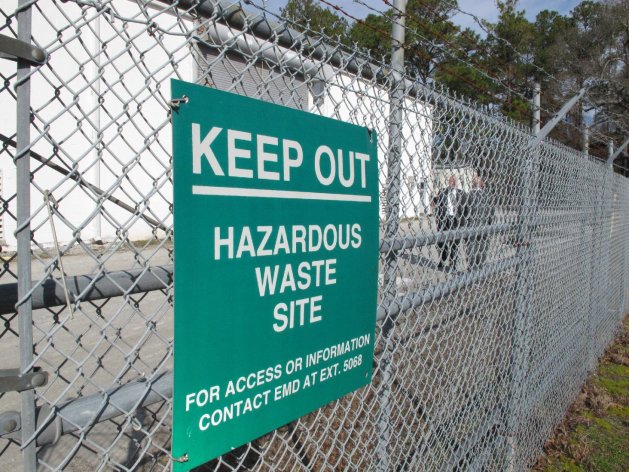From: AP
By | Associated Press
CAMP LEJEUNE, N.C. (AP) — A simple test could have alerted officials that the drinking water at Camp Lejeune
was contaminated, long before authorities determined that as many as a
million Marines and their families were exposed to a witch's brew of
cancer-causing chemicals.
But no one responsible for the lab at the base can recall that the procedure — mandated by the Navy — was ever conducted.
The U.S. Marine Corps
maintains that the carbon chloroform extract (CCE) test would not have
uncovered the carcinogens that fouled the southeastern North Carolina
base's water system from at least the mid-1950s until wells were capped
in the mid-1980s. But experts say even this "relatively primitive" test —
required by Navy health directives as early as 1963 — would have told
officials that something was terribly wrong beneath Lejeune's sandy
soil.
A just-released study from the
federal Agency for Toxic Substances and Disease Registry cited a
February 1985 level for trichloroethylene of 18,900 parts per billion in
one Lejeune drinking water well — nearly 4,000 times today's maximum
allowed limit of 5 ppb. Given those kinds of numbers, environmental
engineer Marco Kaltofen said even a testing method as inadequate as CCE should have raised some red flags with a "careful analyst."
"That's knock-your-socks-off level — even back then," said Kaltofen,
who worked on the infamous Love Canal case in upstate New York, where
drums of buried chemical waste leaked toxins into a local water system.
"You could have smelled it."
Biochemist Michael Hargett
agrees that CCE, while imperfect, would have been enough to prompt more
specific testing in what is now recognized as the worst documented case
of drinking-water contamination in the nation's history.
"I consider it disingenuous of the Corps to say, 'Well, it wouldn't
have meant anything,'" said Hargett, co-owner of the private lab that
tried to sound the alarm about the contamination in 1982. "The levels of
chlorinated solvent that we discovered ... they would have gotten
something that said, 'Whoops. I've got a problem.' They didn't do that."
Trichloroethylene (TCE), tetrachloroethylene (PCE), benzene and other
toxic chemicals leeched into ground water from a poorly maintained fuel
depot and indiscriminate dumping on the base, as well as from an
off-base dry cleaner.
Nearly three decades after the first drinking-water wells were
closed, victims are still awaiting a final federal health assessment —
the original 1997 report having been withdrawn because faulty or
incomplete data. Results of a long-delayed study on birth defects and
childhood cancers were only submitted for publication in late April.
Many former Lejeune Marines and family members who lived there
believe the Corps still has not come clean about the situation, and the
question of whether these tests were conducted is emblematic of the
depth of that mistrust.
Marine Corps officials have repeatedly said that federal
environmental regulations for these cancer-causing chemicals were not
finalized under the Safe Drinking Water Act until 1989 — about four
years after the contaminated wells had been identified and taken out of
service. But victims who have scoured decades-old documents say the
military's own health standards should have raised red flags long
before.
In 1963, the Navy's Bureau of Medicine and Surgery issued "The Manual
of Naval Preventive Medicine." Chapter 5 is titled "Water Supply
Ashore."
"The water supply should be obtained from the most desirable sources
which is feasible, and effort should be made to prevent or control
pollution of the source," it reads.
At the time, the Defense Department adopted water quality standards
set by the U.S. Public Health Service. To measure that quality, the Navy
manual identified CCE "as a technically practical procedure which will
afford a large measure of protection against the presence of undetected
toxic materials in finished drinking water."
Also referred to as the "oil and grease test," CCE was intended to
protect against an "unwarranted dosage of the water consumer with
ill-defined chemicals," according to the Navy manual. The CCE standard
set in 1963 was 200 ppb. In 1972, the Navy further tightened it to no
more than 150 ppb.
In response to a request from The Associated Press, Capt. Kendra Motz
said the Marines could produce no copies of CCE test results for
Lejeune, despite searching for "many hours."
"Some documents that might be relevant to your question may no longer
be maintained by the Marine Corps or the Department of the Navy in
accordance with records management policies," she wrote in an email.
"The absence of records 50 years later does not necessarily mean action
was not taken."
But the two men who oversaw the base lab told the AP they were not even familiar with the procedure.
"A what?" asked Julian Wooten,
who was head of the Lejeune environmental section during the 1970s,
when asked if his staff had ever performed the CCE test. "I never saw
anything, unless the (Navy's) preventive medicine people were doing
some. I don't have any knowledge of that kind of operation or that kind
of testing being done. Not back then."
"I have no knowledge of it," said Danny Sharpe,
who succeeded Wooten as section chief and was in charge when the first
drinking water wells were shut down in the mid-1980s. "I don't remember
that at all."
Wooten was an ecologist, and Sharpe's background is in forestry and soil conservation. But Elizabeth Betz, the supervisory chemist at Lejeune from 1979 to 1995, was also at a loss when asked about the CCE testing.

No comments:
Post a Comment